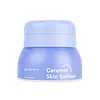What's inside
What's inside
 Key Ingredients
Key Ingredients

 Benefits
Benefits

 Concerns
Concerns

 Ingredients Side-by-side
Ingredients Side-by-side

Water
Skin ConditioningGlycerin
HumectantDimethicone
EmollientBetaine
HumectantButylene Glycol
HumectantPentylene Glycol
Skin ConditioningBisabolol
MaskingCaprylic/Capric Triglyceride
MaskingHydroxyacetophenone
AntioxidantCarbomer
Emulsion StabilisingPolyacrylamide
Tromethamine
BufferingC13-14 Isoparaffin
EmollientAllantoin
Skin ConditioningSodium Hyaluronate
HumectantHydrogenated Lecithin
EmulsifyingAvena Sativa Kernel Extract
AbrasiveAnthemis Nobilis Flower Extract
MaskingLaureth-7
EmulsifyingHydrolyzed Algae Extract
Skin ConditioningDisodium EDTA
Ceramide NP
Skin ConditioningHydrolyzed Collagen
EmollientCaprylyl Glycol
EmollientCaffeine
Skin ConditioningN-Prolyl Palmitoyl Tripeptide-56 Acetate
Skin ConditioningMagnesium Aspartate
Skin ConditioningZinc Gluconate
Skin ConditioningTetrahexyldecyl Ascorbate
AntioxidantPhenoxyethanol
PreservativeCopper Gluconate
Skin Conditioning1,2-Hexanediol
Skin ConditioningWater, Glycerin, Dimethicone, Betaine, Butylene Glycol, Pentylene Glycol, Bisabolol, Caprylic/Capric Triglyceride, Hydroxyacetophenone, Carbomer, Polyacrylamide, Tromethamine, C13-14 Isoparaffin, Allantoin, Sodium Hyaluronate, Hydrogenated Lecithin, Avena Sativa Kernel Extract, Anthemis Nobilis Flower Extract, Laureth-7, Hydrolyzed Algae Extract, Disodium EDTA, Ceramide NP, Hydrolyzed Collagen, Caprylyl Glycol, Caffeine, N-Prolyl Palmitoyl Tripeptide-56 Acetate, Magnesium Aspartate, Zinc Gluconate, Tetrahexyldecyl Ascorbate, Phenoxyethanol, Copper Gluconate, 1,2-Hexanediol
Water
Skin ConditioningButylene Glycol
HumectantCastanea Crenata Shell Extract
Skin ConditioningPEG-60 Hydrogenated Castor Oil
EmulsifyingCinnamomum Cassia Bark
Skin ConditioningAnthemis Nobilis Flower Extract
MaskingRhus Semialata Gall Extract
Skin ConditioningCaprylyl Glycol
EmollientCarbomer
Emulsion StabilisingTriethanolamine
BufferingSalix Alba Bark Extract
Astringent1,2-Hexanediol
Skin ConditioningAllantoin
Skin ConditioningAmmonium Acryloyldimethyltaurate/Vp Copolymer
Camellia Sinensis Leaf Extract
AntimicrobialYeast Ferment Extract
Skin ConditioningEthylhexylglycerin
Skin ConditioningDipotassium Glycyrrhizate
HumectantMentha Haplocalix Extract
MaskingHamamelis Virginiana Leaf Extract
Skin ConditioningMenthyl Lactate
MaskingGlycerin
HumectantHydrolyzed Albumen
Skin ConditioningScutellaria Baicalensis Root Extract
AstringentBeta-Glucan
Skin ConditioningGlycine
BufferingGlutamic Acid
HumectantHistidine
HumectantLysine
Skin ConditioningProline
Skin ConditioningSerine
MaskingAlanine
MaskingArginine
MaskingAspartic Acid
MaskingLeucine
Skin ConditioningThreonine
Valine
MaskingParfum
MaskingPhenoxyethanol
PreservativeLimonene
PerfumingLinalool
PerfumingHexyl Cinnamal
PerfumingCitronellol
PerfumingWater, Butylene Glycol, Castanea Crenata Shell Extract, PEG-60 Hydrogenated Castor Oil, Cinnamomum Cassia Bark, Anthemis Nobilis Flower Extract, Rhus Semialata Gall Extract, Caprylyl Glycol, Carbomer, Triethanolamine, Salix Alba Bark Extract, 1,2-Hexanediol, Allantoin, Ammonium Acryloyldimethyltaurate/Vp Copolymer, Camellia Sinensis Leaf Extract, Yeast Ferment Extract, Ethylhexylglycerin, Dipotassium Glycyrrhizate, Mentha Haplocalix Extract, Hamamelis Virginiana Leaf Extract, Menthyl Lactate, Glycerin, Hydrolyzed Albumen, Scutellaria Baicalensis Root Extract, Beta-Glucan, Glycine, Glutamic Acid, Histidine, Lysine, Proline, Serine, Alanine, Arginine, Aspartic Acid, Leucine, Threonine, Valine, Parfum, Phenoxyethanol, Limonene, Linalool, Hexyl Cinnamal, Citronellol
Alternatives
Ingredients Explained
These ingredients are found in both products.
Ingredients higher up in an ingredient list are typically present in a larger amount.
1,2-Hexanediol is a synthetic liquid and another multi-functional powerhouse.
It is a:
- Humectant, drawing moisture into the skin
- Emollient, helping to soften skin
- Solvent, dispersing and stabilizing formulas
- Preservative booster, enhancing the antimicrobial activity of other preservatives
Allantoin is a soothing ingredient known for its protective and moisturizingg properties. Because of this, it is often added to products with strong active ingredients.
Studies show higher concentrations of this ingredient can promote wound healing.
Though it can be derived from the comfrey plant, allantoin is produced synthetically for cosmetic products to ensure purity.
Learn more about AllantoinAnthemis Nobilis Flower Extract is from the Roman Chamomile flower. It helps soothe the skin and contains antioxidants.
Butylene Glycol (or BG) is used within cosmetic products for a few different reasons:
Overall, Butylene Glycol is a safe and well-rounded ingredient that works well with other ingredients.
Though this ingredient works well with most skin types, some people with sensitive skin may experience a reaction such as allergic rashes, closed comedones, or itchiness.
Learn more about Butylene GlycolCaprylyl Glycol is a humectant and emollient, meaning it attracts and preserves moisture.
It is a common ingredient in many products, especially those designed to hydrate skin. The primary benefits are retaining moisture, skin softening, and promoting a healthy skin barrier.
Though Caprylyl Glycol is an alcohol derived from fatty acids, it is not the kind that can dry out skin.
This ingredient is also used as a preservative to extend the life of products. It has slight antimicrobial properties.
Learn more about Caprylyl GlycolCarbomer is a polymer of acrylic acid. Its main role is to create a gel consistency.
A high amount of carbomer can cause pilling or balling up of products. Don't worry, most products contain 1% or less of carbomer.
Glycerin is already naturally found in your skin. It helps moisturize and protect your skin.
A study from 2016 found glycerin to be more effective as a humectant than AHAs and hyaluronic acid.
As a humectant, it helps the skin stay hydrated by pulling moisture to your skin. The low molecular weight of glycerin allows it to pull moisture into the deeper layers of your skin.
Hydrated skin improves your skin barrier; Your skin barrier helps protect against irritants and bacteria.
Glycerin has also been found to have antimicrobial and antiviral properties. Due to these properties, glycerin is often used in wound and burn treatments.
In cosmetics, glycerin is usually derived from plants such as soybean or palm. However, it can also be sourced from animals, such as tallow or animal fat.
This ingredient is organic, colorless, odorless, and non-toxic.
Glycerin is the name for this ingredient in American English. British English uses Glycerol/Glycerine.
Learn more about GlycerinPhenoxyethanol is a preservative that has germicide, antimicrobial, and aromatic properties. Studies show that phenoxyethanol can prevent microbial growth. By itself, it has a scent that is similar to that of a rose.
It's often used in formulations along with Caprylyl Glycol to preserve the shelf life of products.
Water. It's the most common cosmetic ingredient of all. You'll usually see it at the top of ingredient lists, meaning that it makes up the largest part of the product.
So why is it so popular? Water most often acts as a solvent - this means that it helps dissolve other ingredients into the formulation.
You'll also recognize water as that liquid we all need to stay alive. If you see this, drink a glass of water. Stay hydrated!
Learn more about Water